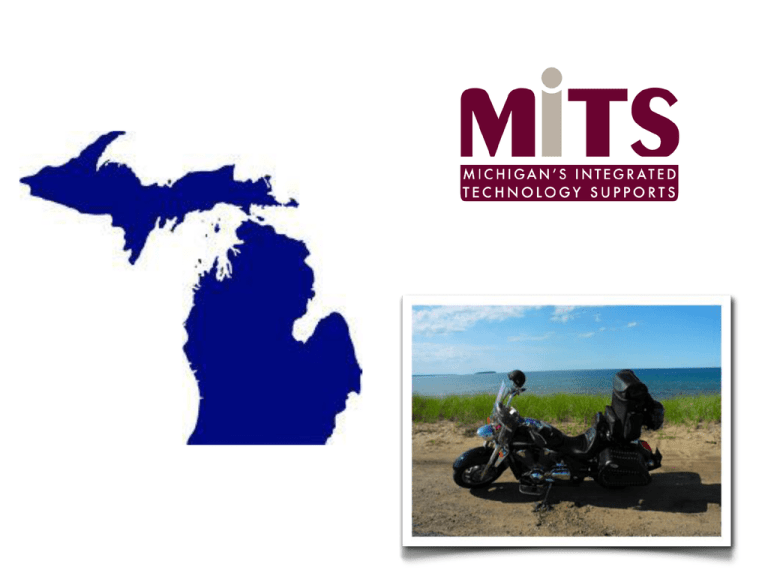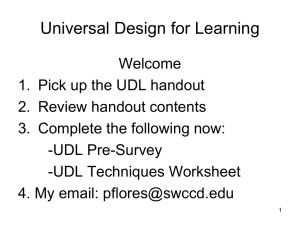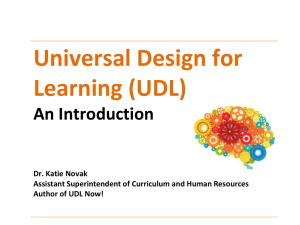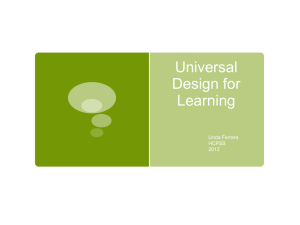UDL Pilot Classrooms – Jeff Diedrich
advertisement

UDL Pilot Classrooms GOAL: ‣ Collaboratively define a practical model of UDL ‣ Create a replicable model What did we do? Lots of dialogue! Emphasized pedagogy Dug into the Principles of UDL Slowly and purposefully introduced technology Identified “Critical Elements” of UDL Respected One Another Learned Mandatory Ingredients • Lots of options to help with the dish Critical Elements Clear Goals ✓ Teachers have a clear understanding of the goal(s) of the lesson and specific student outcomes ✓ Students understand and can express the expectations (goals) of the lesson. Inclusive, Intentional Planning ✓ Intentional proactive planning addressing diverse student needs Addresses individual differences in background knowledge, affect, strategies, etc. Recognizes that all students learn differently and thus plans accordingly ✓ Addresses the demands of the curriculum and available materials and personnel Maintaining rigor of the lesson while embedding necessary supports from the beginning to reduce barriers in the curriculum Flexible Methods & Materials ✓ A variety of methods are used to engage every student (e.g., provide choice, address student interest) and promote their ability to monitor their own learning ✓ Variety of media and methods to present information & content ✓ Variety of media and methods to demonstrate knowledge Timely Progress Monitoring ✓Formative assessments are frequent and timely enough to plan/redirect instruction and support ✓A variety of formative and summative assessments (e.g., projects, oral tests, written tests) are used to assess the learning of the students in the classroom Must be evidence that ALL four critical elements were considered in order to be aligned with the framework of UDL Role of Technology? 1998: Schools in 2010 will look very different as a result of technology. -Tom Carroll National Commission on Teaching and America’s Future (NCTAF) Technology will change schools. So we have to! Education 1.0 Tom Carroll 2011 SETDA Regional Mtg - Chicago • Learning to Know (artisan practice) A lot of what we are doing with technology is only buttressing the learning to know model Education 2.0 Tom Carroll 2011 SETDA Regional Mtg - Chicago • Learning to Do • How do I solve problems? • How do I work with people? Will either model ultimately get us where we need to be? Probably not… Teacher Feedback UDL Pilot Group Teacher Comments The first few meetings we left and thought, “What have we really accomplished,” but now we realize the pedagogical background was necessary for understanding and implementing UDL. We wouldn’t be where we are without that. UDL Pilot Group Teacher Comments Learning about UDL has increased my frustration with what I am able to do in the classroom. I know there is so much more that I could be doing to assist my students in their learning, and I don't have time to do it all, find the necessary resources, etc. I don't think that the time issue is any different from before I tried to organize my classroom around UDL principles - time is always an issue for teachers - but what I need to do with that time has changed. Making traditional assessments more accessible, finding accessible print materials, and the means for students to use those materials. UDL Pilot Group Teacher Comments I have really really really enjoyed being able to spend meaningful time with other teachers, sharing ideas, exploring materials and methods, and working on the business of being better classroom instructors. Having MITS facilitate theses meetings has been priceless. UDL Pilot Group Teacher Comments I think differently about students in the margins, especially struggling readers. I used to try to figure out how to get the student some remedial reading instruction so that they could access my science content. Now, I look for the right materials and methods to get the content to all students. I think about this proactively - before I know anything about the abilities of my students. I want the materials to be readily accessible for whomever walks through my classroom door, regardless of their current reading ability. UDL Pilot Group Teacher Comments I’ve thought about all that I thought I knew about UDL and realized I didn’t know as much as I thought back then! We discussed how we’d like to go back and take our names off of our earlier UDL model lessons. Study and trial and error has helped us understand what UDL is. UDL Pilot Group Teacher Comments I think about students with different needs. It’s hard for some students to just listen to directions so I’ve started providing rubrics and more detailed expectations and directions for them. UDL Pilot Group Teacher Comments The science teachers in the UDL project have created a virtual learning community of sorts. We share information about lessons, discuss how to present ideas to students, and share materials. It’s great being able to bounce ideas off of each other and it’s nice to collaborate with someone who teaches the same content area. UDL Pilot Group Teacher Comments Learning about UDL has had several “light bulb” type moments. When used effectively in class, all students are actively engaged, they are learning at a variety of levels, and they have many opportunities to be successful. Implementing a UDL classroom takes time and some knowledge/access to technology, but once in place needs minimal tweaking in the long run. You won’t have to necessarily change your lessons year-to-year based on the population of students in your classroom because you will have activities/lessons that meet students’ needs that are at a variety of ability levels. •`




